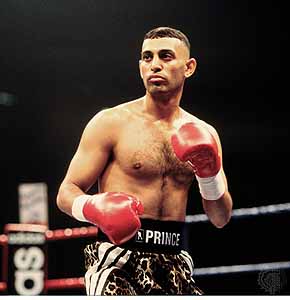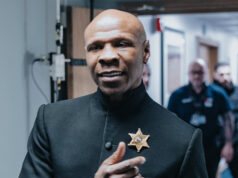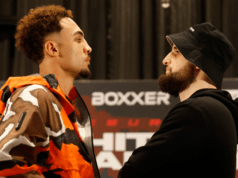-Prince vs. Pacman in a Featherweight Fantasy Fight-
From the day he captured the WBO Featherweight Crown in 1996 until his early 2002 retirement, Naseem Hamed effectively was the featherweight division. His brash style and bone-crunching power made him the division’s star, and when Hamed crossed over the Atlantic from his British base to begin fighting on HBO, he became the big money fight for anyone toiling away at 122 or 126 lbs. In the era when the Morales vs. Barrera rivalry was just developing and Manny Pacquiao was merely a blip on the radar, Hamed brought fans, fame and big money to the lower weight classes.

The end of his career came suddenly, when Hamed was out-boxed and roughed up by Marco Antonio Barrera in 2001. By then Hamed had been slipping for some time. He fired Brendan Ingle in 1999, the man who had trained him from the age of nine. From that point forward, Hamed showed an increasing lack of focus, and in truth the Yemeni from Sheffield had probably lost much of his interest in boxing. He made no attempt at a comeback, and fought only once more so he could retire with a win at a youthful 28.
But what if Hamed’s loss to Barrera had re-invigorated him, instead of encouraging the Prince to retire early? After another tune-up fight, followed by either a win in a rematch with Barrera or against another top featherweight, and by 2003 Hamed would have found himself squarely in the path of a rising tornado from the Philippines, the 25 year old Manny Pacquiao. It would have been an encounter between two southpaw featherweight punchers, yet of very different molds, and both in their prime.
The Formalities
No title is on the line, but as Pacquiao is almost unknown in the United States at this point, Hamed gets the champion’s post and is introduced second. The Prince rides into the ring on a parade float-style Arab dhow, dismounts, spends 15 minutes slinking about to techno beats, and then flips over the top rope.
The Prince vs. Pacman
At the opening bell, Pacquiao makes his way across the ring and immediately beats Hamed to the punch. The Prince remains cocky on the surface, but begins backing away from his adversary, as this is the first time he has ever fought an opponent who can match or surpass his speed. Using his reach, speed and height, Pacquiao is able to score repeatedly, but not with his trademark right hook. Hamed’s reflexes are too quick for that. Hamed drops Round 1 on all three scorecards.
Hamed also loses Round 2 and throws very few punches, but he begins to back up less and starts trying to time and counter the Filipino. The result is that Hamed catches his first Pacquiao hook, which deposits Hamed right on his ass. The Prince was always prone to knockdowns, but this was usually due to bad balance, and in this instance Pacquiao caught Hamed lunging in with a straight left. Hamed is essentially unhurt and smirks at Pacquiao as if he knows something.
Round 3 is more of the same. Back in the corner, trainer Emmanuel Steward implores Hamed to throw more punches. Hamed winks and says “sure.” Pacquiao, confident, scoring more and having tasted none of Hamed’s power, surges forward looking to put some hurt on the Yemeni from Sheffield. Pacman comes right at him and gives the Prince exactly what he wants. Hamed takes a quarter step into exactly the right place and turns his tree trunk-thick legs loose for the first time in the fight, felling Pacquiao with a straight left-right uppercut combo. The right uppercut lifts the Filipino off the canvas, twists him in mid-air, and sends him flying – literally flying – to the canvas.
Pacman has not been hurt so badly since he was knocked out by a body shot in 1999, and Hamed’s British fans roar their approval as he dances his way to a neutral corner. Pacquiao struggles to his feet by the count of nine, blood trickling out of the corner of his mouth. It will later be revealed that two of his teeth were broken (not knocked out, but broken) by the uppercut. With 35 seconds to go, Pacquiao wisely covers up and clinches Hamed, refusing to give the Prince anymore chances to land his power.
The Prince Stalks His Prey
Pacman reverts to pure defense for all of Round 5, his legs made of rubber. His right jab is what saves him, as Hamed has trouble getting past the rapier-quick dart that is constantly shot in his face. It is little more than a slap, but because Hamed’s hands are often down around his waist, it prevents him from seeing well enough to attempt to pound Pacquiao’s body or drive his guard apart with a telephone pole straight left. Pacquiao starts re-asserting himself in Round 6, but loses that round as well.
Fed Into The Mincer
Round 7 sees Manny Pacquiao borrow a page from Marco Antonio Barrera’s book – he steps in, fires a rapid three- or four-punch combo, and steps out. The problem is that at this stage in his career, Pacquiao lacks the footwork to consistently stick-and-move against the nimble Hamed (his balance might have been bad, but the man’s entire defense was bound up in those feet, and prime Hamed was hard to hit on the move). Hamed keeps his hands low and eats a punch or two if it means he can slam one straight left or right hook into Pacquiao’s body or face.
Unlike any of Hamed’s past opponents, Pacquiao is quick enough to hit Hamed, even when Hamed does not want to be hit. Unlike any of Pacquiao’s opponents, past or future, Hamed has the speed and reflexes to make Pacman miss about half the time, while the other half of the blows are at least seen by Hamed coming in. Pacquiao has never been a brute force puncher, but one who relies on speed and shock. So, he lands a lot of leather on Hamed in Rounds 7 through 10, but never quite manages to catch him with the surprise, electrified blow. For his part, Hamed manages to land only one counter-punch at a time, but that shot lands with the force of a mule kick. These rounds are also ugly to score, as it is a question of volume vs. effect.
The End
By Round 11, Hamed’s face is a mess. His left eye is closing from eating right hook after right hook, limiting his vision. Pacquiao is slowing down, suffering from bruised ribs, and his mouth has never stopped bleeding. Yet with the heart of a champion, Pacquiao decides to turn up the pressure on the Prince and gamble. For the first time since the early rounds of the fight, the old-style Pacman offensive is on again. Hamed lurches backward, drawing Pacquiao in for a vicious right uppercut to the body. That shot never lands, however, as Pacquiao lands a double right hook that Hamed cannot see. Hamed’s head twists with the force, and Pacquiao lands a lightning quick straight left onto his temple at just the right moment. Hamed collapses backward onto the canvas. He gets up by the count of seven, but Pacquiao catches his second wind as he sees his rival hurt. Swarming Hamed, he lands blow after blow, forcing the referee to stop the fight.
The stoppage came just in time. Hamed was leading on the scorecards, just barely, but Pacquiao needed to bag both Rounds 11 and 12 just to win a Split Decision. One of three judges scored Round 4 a 10-7, despite only one knockdown taking place. After the fight, Pacman was rushed to the hospital due to internal injuries. He won the fight, but took enormous damage in doing so. He would later say of the knockdown in Round 4 that “the only reason I knew I wasn’t dead was because I was in too much pain.”
Just as the loss to Barrera brought Hamed back to boxing, the brutal win over Hamed led Pacquiao to start improving his style. Instead of the raw, speedy puncher, the Filipino would begin to evolve into a polished boxer-puncher. Hamed would come back again, crush Marco Antonio Barrera in a rubber match, and then drop a points loss to Erik Morales before retiring. After perfecting his style against some mid-ranked featherweights, Pacquiao would challenge featherweight king Erik Morales and beat him twice. He would also fight Juan Manuel Marquez at 126 lbs., and out-point that Mexican as well.










